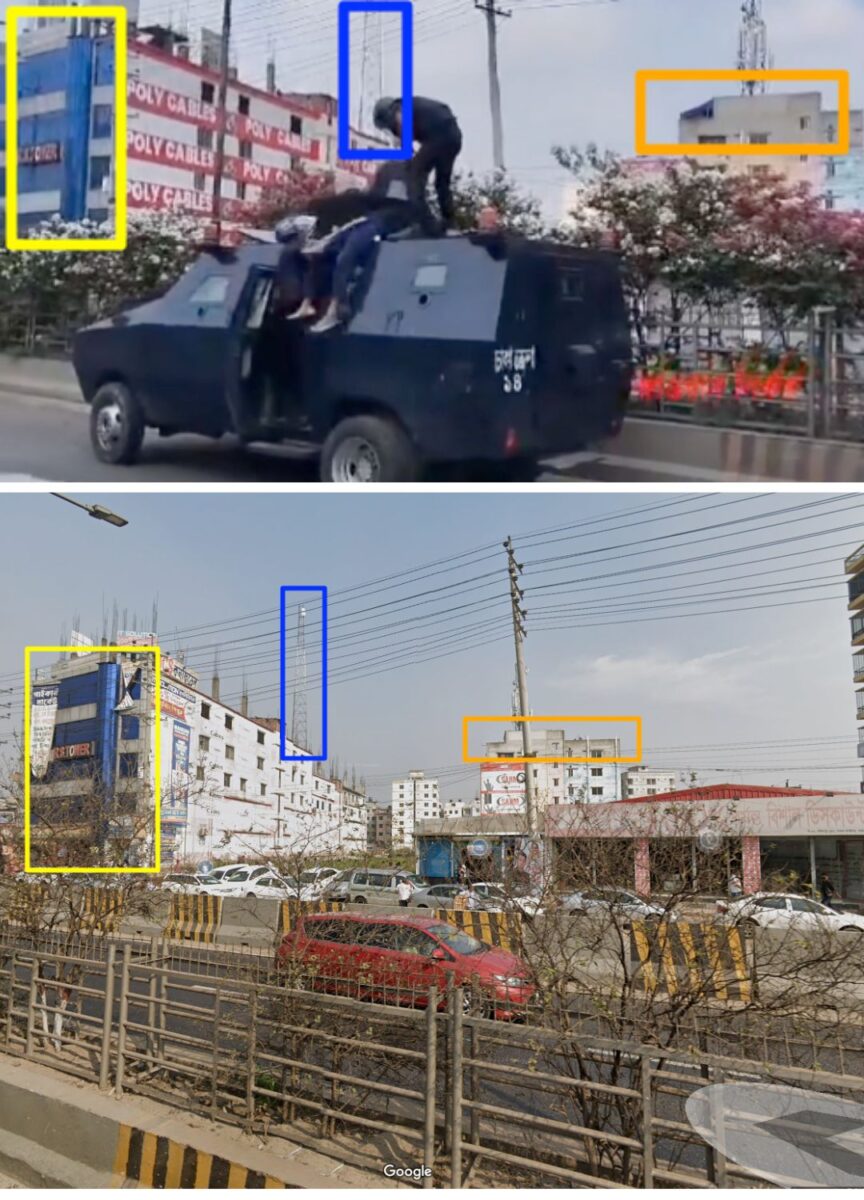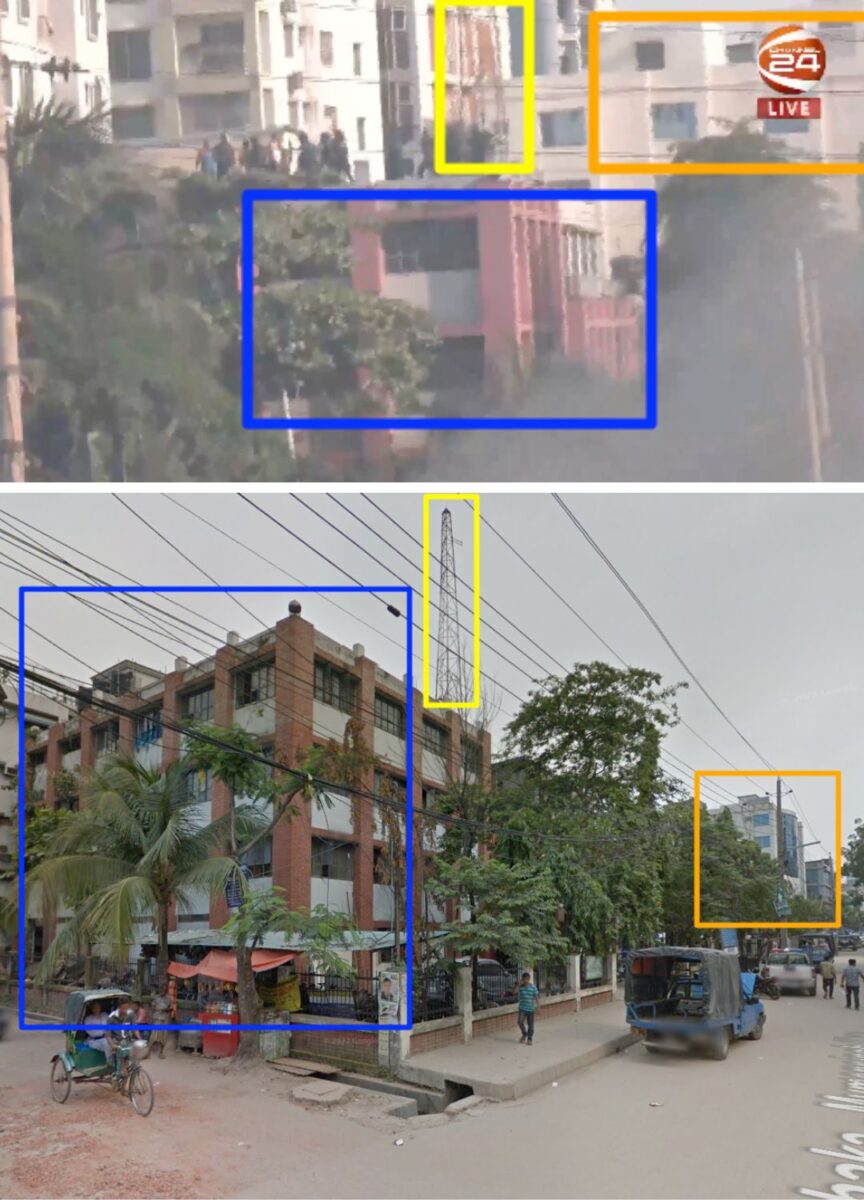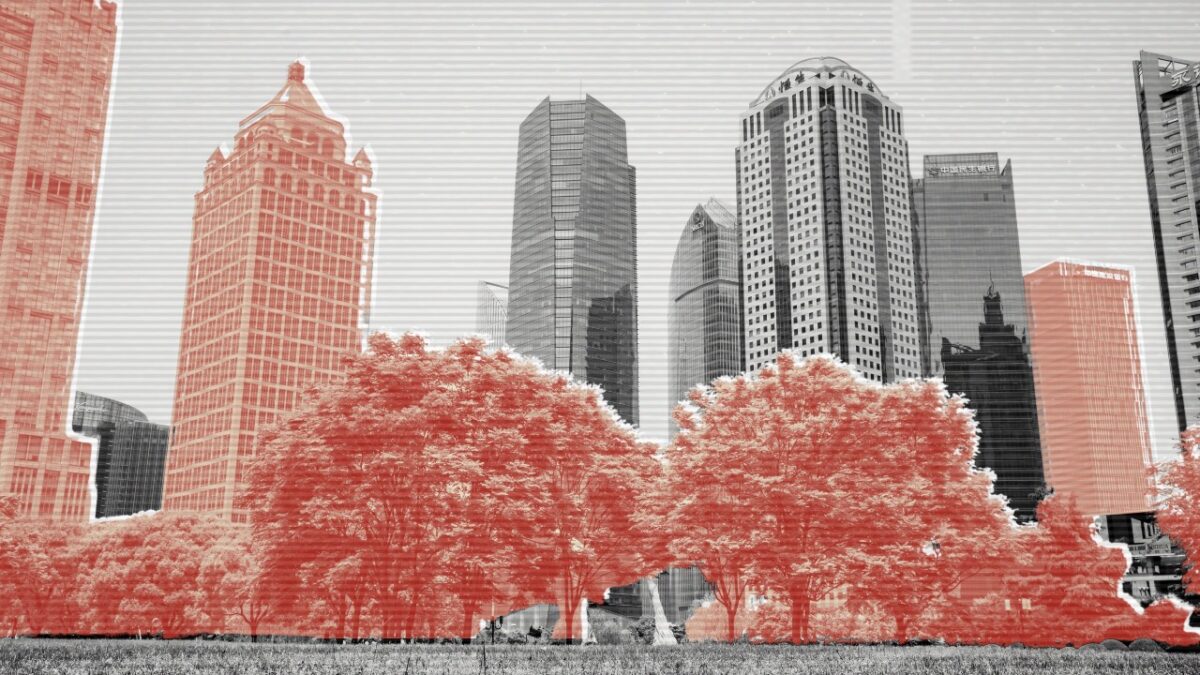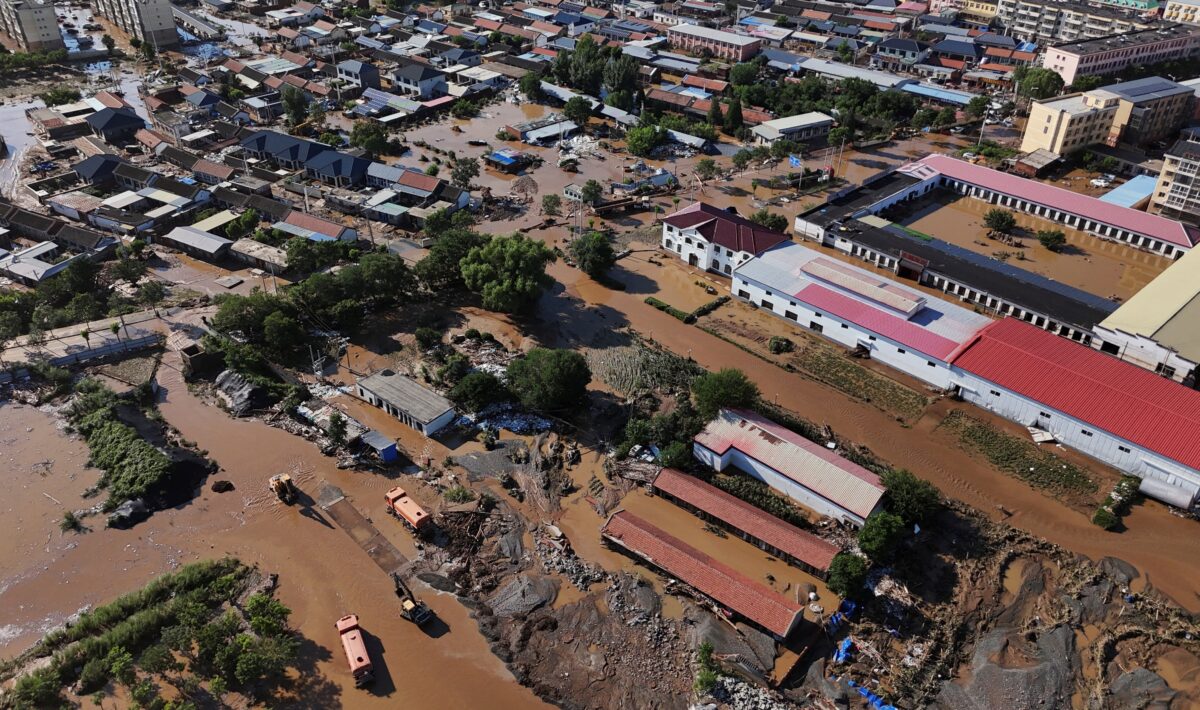The Fall of Sheikh Hasina: Footage from the Streets of Bangladesh
Bangladesh’s Prime Minister Sheikh Hasina was forced to resign and flee the country on Monday, landing by helicopter in India just after lunchtime.
Her dramatic fall from power comes after tens of thousands of protesters gathered on the streets of Dhaka throughout Sunday and early Monday, in defiance of a nationwide curfew, calling on Hasina to resign.
The protests had been building throughout July over plans to reinstate a quota that would have reserved a percentage of government jobs for veterans of Bangladesh’s war of independence.
On Monday morning a near-total internet shutdown was imposed, a tactic that has frequently been used to try to quell protests in the country. Footage revealing how the protests escalated is still emerging as a result.
Yet videos analysed by Bellingcat from the final hours of Hasina’s rule reveal police being outnumbered on the streets of the Bangladeshi capital as protesters took control, with police resorting to firing from the rooftops of several police stations.
We also identified incidents of police violence against unarmed protesters and attacks against buildings affiliated with Hasina’s Awami League political party.
How Hasina’s Control Unraveled
On Friday, August 2, Netblocks reported that Facebook, WhatsApp and Telegram had been restricted, continuing a pattern of blockages that occurred during earlier protests in July.
Several incidents of violence were reported in northern Dhaka’s Uttara neighbourhood in Sector 11.
Bellingcat identified protesters running away from police apparently firing tear gas towards them in Sector 11, here: 23.8781591,90.3907882.

Another video, shot on the same day in the same area, shows police firing down the street, less than 200m away from Shaheed Monsur Ali Medical College Hospital.
A third video taken on the same street shows police thrashing an unarmed civilian. The man is then carried away by two other people.

Bangladesh’s largest national newspaper Prothom Alo reported that clashes broke out after police attempted to break up a planned student march starting from Milestone College in Uttara Sector 11 about 5pm on Friday. Police fired sound grenades, tear gas canisters and rubber bullets at protesters, injuring at least six people.
How it Started: Anti-Quota Protests
Protests began in late July with students taking to the streets to demand an end to the government job quota which reserved 30 percent of jobs for the relatives of veterans who took part in Bangladesh’s war of independence.
The quota made competitive government jobs even more inaccessible to the wider population and students argued it favoured supporters of the ruling party.
This policy was previously scrapped in 2018 following widespread protests but was reinstated in June, sparking the latest wave of dissent.
Despite the mostly peaceful nature of the protests, more than 200 people, mostly students, were reportedly killed, with local counts putting the figures much higher.
The use of lethal force by police in response drew widespread condemnation from human rights groups, and it marked the most deadly violence in Bangladesh since its 1971 war of independence.
Despite the scaling back of the quota on July 21, protests continued over police violence and students called for Hasina to resign.
Earlier Incidents of Police Violence
Bellingcat verified footage from a number of incidents of police violence during the July protests, showing unarmed protesters being attacked.
In footage (Warning: Graphic content) from Dhaka’s Jatrabari neighbourhood, coordinates 23.705481,90.4448897, a police officer can be seen shooting pellets at an injured student being carried. The protester is left immobile causing the man carrying him to abandon him and flee.
Some posts on social media identify the protester as Eman Hasan Taim, although Bellingcat was not able to independently verify this. Taim, 17, is listed as among the dead by Shohid, a website compiling a list of those who died in the violence.
Several videos show a vehicle owned by Bangladesh’s elite paramilitary force, the Rapid Action Battalion (RAB), ramming into protesters in Uttara at 23.868263, 90.400344 before protesters violently attack (Warning: Graphic content) the driver.
Another video, taken at 23.7621326,90.443909 in Dhaka’s Bansree neighbourhood, shows police firing at a person trying to hide by hanging from a building.
Separately, several videos taken in Dhaka’s neighbouring city of Savar shows a man being carried on the roof of an Armoured Personnel Carrier (APC) along the Dhaka-Aricha Highway at 23.8465328,90.2570423.
The man, who appears to be unconscious is then pulled off the roof of the vehicle by two police officers, onto the road.
As the vehicle drives away someone can be heard in the footage asking, “Is he dead?”
The victim was later identified as Shykh Yamin, a student of the Military Institute of Science and Technology (MIST).
Bellingcat was unable to find details of Yamin’s death but Amnesty consulted an independent forensic pathologist who examined photographic evidence of his wounds to chest, concluding that his death could reasonably be presumed to have been caused by birdshot pellet injuries.

Saturday, August 3:
Huge crowds gathered on the streets across Bangladesh’s main cities, demanding a public apology from Hasina for the violence and killings and calling for her to leave office.
Protesters blocked main roads in Bangladesh’s second-largest city Chittagong (officially known as Chattogram) and gathered in Dhaka’s largest shopping area near the city centre.
Chittagong, Bangladesh, 03 August 2024 pic.twitter.com/mxUAiXS4uc
— ParanjoyGuhaThakurta (@paranjoygt) August 4, 2024
Student protesters declared an indefinite non-cooperation movement and mass gatherings took place in several areas.
Sunday, August 4:
By Sunday, widespread rallies were continuing across Dhaka and multiple skirmishes broke out between police, protesters and supporters of Hasina’s Awami league. At least 13 police officers and 90 civilians were reportedly killed in the clashes.
The government imposed an indefinite curfew across the country.
We geolocated the following footage showing a vehicle ploughing into a crowd of people on the street at high speed to this location 25.01713,90.0136716 outside a ceramics showroom in the northern city of Sherpur.

Social media posts claimed the vehicle was a police car. Bellingcat could not verify this from the footage alone as the vehicle had no obvious distinguishing markings that would immediately identify it as a police vehicle. It was also not possible to confirm the number of injuries from this incident, although one individual appeared to be directly hit and was tossed violently into the air.

Violence also broke out in Dhaka as protesters gathered near the Prime Minister’s residence. A video captured protesters outside a police station, some armed with sticks attacking what did appear to be a police vehicle and others throwing objects towards the station. Above them, police can be seen firing from a rooftop which X user PowerPigeon2 geolocated to the Khilgaon Police Station at 23.750973, 90.425147.
In addition to the police, a number of people in civilian clothes can be seen on the roof of the police station throwing objects at individuals on the street. The street soon clears out as someone behind the camera can be heard saying in Bengali, “There’s blood on the road”.

Another video taken approximately 100m from the Khilgaon Police Station at 23.7502851,90.4254509 shows police firing their weapons down the street. The police appear to be accompanied by men in civilian clothes carrying batons and throwing objects. A video taken from a different angle shows the same scene.

Bellingcat was not able to verify who the people in plain clothes were, but footage clearly shows multiple people in civilian clothing alongside police throwing objects towards protesters. Protesters told the Guardian that police and members of the Bangladesh Chhatra League (BCL), the student wing of Hasina’s Awami League, have attacked protesters together.
On Sunday night Hasina reportedly met with her army chief and military generals who said they would not enforce the curfew or fire on protesters, according to Reuters reports citing army sources. Prothom Alo reported that officials tried to convince Hasina to relinquish power and explain that the protests could not be put down by force, but according to the BBC, it was only after they recruited family members to intercede that Hasina agreed to leave.
Monday, August 5:
On Monday morning a near-total national internet shutdown occurred nationwide. Despite the curfew, tens of thousands of people gathered in Dhaka and began making their way to Hasina’s residence.
A video showed police firing their weapons from a rooftop which Bellingcat geolocated to the Uttara East Police Station, here 23.8675773,90.4003782. Several men in civilian clothes can also be seen on the roof throwing stones. Videos of people carrying the injured (1, 2) in the same area were also shared online.

Dhaka-based English language newspaper Daily Star reported that protesters and police clashed at the site for hours, with police firing bullets, rubber bullets and tear gas from the roof of the station which protesters stormed. At least 21 people, including a policeman, were reportedly killed and more than 100 injured at the site.
In the west, in Jashore, a hotel located at 23.1656977,89.2083993 was set on fire by unidentified men reportedly killing at least 24 people. The hotel was owned by a leader of the Awami League.
Similar scenes played out at a number of locations across the country. Prothom Alo reported that a number of government official’s houses, the offices of the Awami League, police stations and other government installations were attacked, vandalised and torched in 39 districts.
Elsewhere in the capital, protesters celebrated on the streets after it became clear the army would not enforce the curfew and upon confirmation that Hasina had left, flying by helicopter from her residence, eventually landing in Delhi after lunchtime.
What’s next for Bangladesh?
The students’ victory comes against the backdrop of immense violence documented in videos, especially in the capital. A number of outlets have been attempting to document and identify all the protesters who have been killed since demonstrations began. At least 90 people, including police officers, were killed in the renewed protests and clashes over the weekend.
Yesterday, Bangladesh’s Nobel laureate and widely respected economist Muhammad Yunus–a popular choice amongst student demonstrators – agreed to head the country’s interim government.
Jake Godin, Lucy Swinnen and Rob Cecilio from Bellingcat’s Discord community contributed reporting to this piece.
Bellingcat is a non-profit and the ability to carry out our work is dependent on the kind support of individual donors. If you would like to support our work, you can do so here. You can also subscribe to our Patreon channel here. Subscribe to our Newsletter and follow us on Twitter here and Mastodon here.


